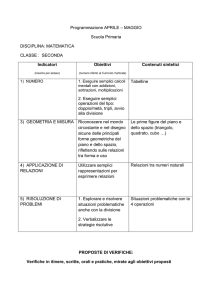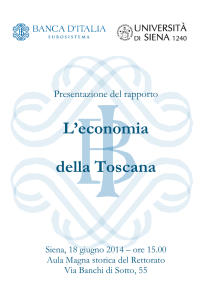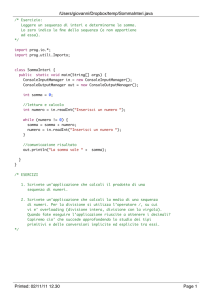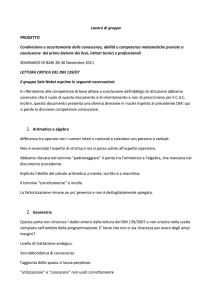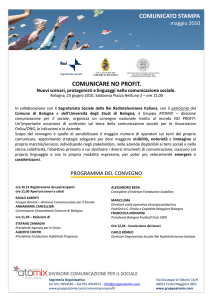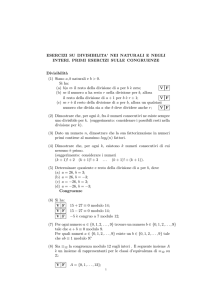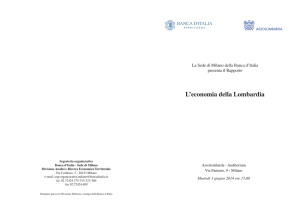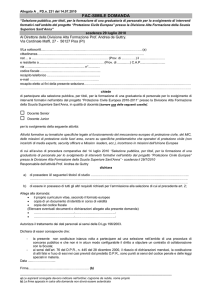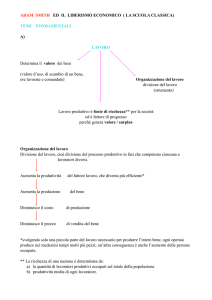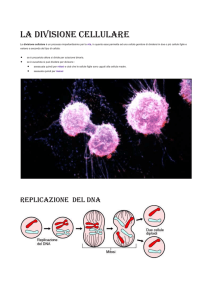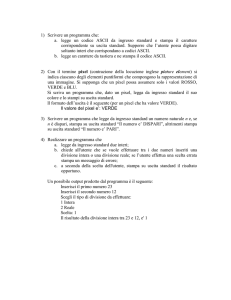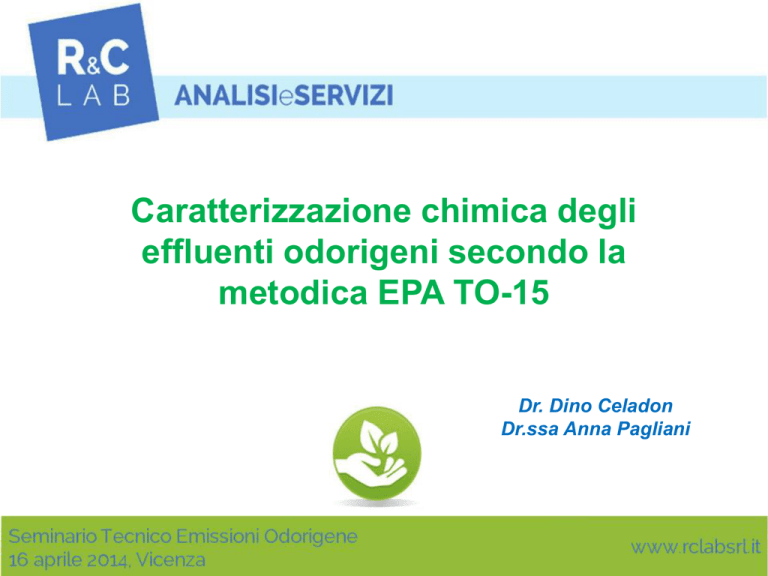
Caratterizzazione chimica degli
effluenti odorigeni secondo la
metodica EPA TO-15
Dr. Dino Celadon
Dr.ssa Anna Pagliani
DIVISIONE AMBIENTALE
Presentazione del lavoro
- Introduzione alla metodica EPA TO-15
- Descrizione dei mVOCs
- Applicazione del metodo all’analisi del rischio chimico in fasi
preparative del laboratorio di microbiologia
- Applicazione del metodo all’analisi dell’inquinamento alimentare
- Applicazione del metodo all’analisi dell’inquinamento indoor
w
w
w
.
r
c
l
a
b
s
r
l
.
i
t
DIVISIONE AMBIENTALE
w
w
w
.
r
c
l
a
b
s
r
l
.
i
t
DIVISIONE AMBIENTALE
Campionamento dell’aria
w
w
w
.
r
c
l
a
b
s
r
l
.
i
t
DIVISIONE AMBIENTALE
Trasferimento VOCs al gascromatografo
w
w
w
.
r
c
l
a
b
s
r
l
.
i
t
DIVISIONE AMBIENTALE
Analisi gascromatografica in spettrometria di massa
w
w
w
.
r
c
l
a
b
s
r
l
.
i
t
DIVISIONE AMBIENTALE
Taratura
w
w
w
.
r
c
l
a
b
s
r
l
.
i
t
DIVISIONE AMBIENTALE
w
w
w
.
r
c
l
a
b
s
r
l
.
i
t
DIVISIONE AMBIENTALE
Analisi quantitativa
w
w
w
.
r
c
l
a
b
s
r
l
.
i
t
DIVISIONE AMBIENTALE
w
w
w
.
r
c
l
a
b
s
r
l
.
i
t
DIVISIONE AMBIENTALE
Possibile utilizzo della quantificazione con EPA TO-15
NORMA UNI EN 13725:2004
w
w
w
.
r
c
l
a
b
s
r
l
.
i
t
DIVISIONE AMBIENTALE
Analisi qualitativa
w
w
w
.
r
c
l
a
b
s
r
l
.
i
t
MICROBIAL VOCs
w
w
w
.
r
c
l
a
b
DIVISIONE AMBIENTALE
s
r
l
.
i
t
DIVISIONE AMBIENTALE
Ad oggi si conoscono 349 batteri e 69 funghi che producono
durante la loro attività metabolica mVOCs
http://bioinformatics.charite.de/mvoc/
w
w
w
.
r
c
l
a
b
s
r
l
.
i
t
DIVISIONE AMBIENTALE
H2O Peptonata: Salmonella
w
w
w
.
r
c
l
a
b
s
r
l
.
i
t
DIVISIONE AMBIENTALE
Inserire cromatogramma h20 peptonata
w
w
w
.
r
c
l
a
b
s
r
l
.
i
t
DIVISIONE AMBIENTALE
Methanthiol (Metilmercaptano): CAS 74-93-1
H331: Tossico se inalato
P260: Non respirare i gas/vapori
Dimethyl disulfide: CAS 624-92-0 (Lattobacilli, Enterococchi, Enterobatteri..)
H301+H331: Tossico se ingerito o inalato
H319: Provoca grave irritazione oculare
P233: Tenere il recipiente ben chiuso
P262: Evitare contatto con occhi, pelle,
indumenti
1-Butanol: CAS 71-36-3 (Enterococchi, Salmonella, Enterobatteri, funghi….)
H302: Nocivo se ingerito
H315: Provoca irritazione cutanea
H318: Provoca gravi lesioni oculari
P335: Può irritare l vie respiratorie
P280: Proteggere gli occhi
Dimethyl trisulfide: CAS 3658-80-8 (Bacilli, Streptomiceti, Attinomiceti….)
H332: Nocivo se inalato
H302: Nocivo se ingerito
H319: Provoca grave irritazione oculare
H315: Provoca irritazione cutanea
P280: indossare guanti/indumenti
protettivi/proteggere gli occhi/il viso
m-XYLENE: CAS: 108-38-3, p-XYLENE CAS: 106-42-3, o-XYLENE CAS: 95-47-6 (Pseudomonas
fragi)
H332: Nocivo se inalato
H312: Nocivo per contatto con la pelle
H315: Provoca irritazione cutanea
w
w
w
.
r
c
l
a
H315: Provoca irritazione cutanea
P280: indossare guanti/indumenti
protettivi/proteggere gli occhi/il viso
b
s
r
l
.
i
t
DIVISIONE AMBIENTALE
Fraser: Listeria
w
w
w
.
r
c
l
a
b
s
r
l
.
i
t
DIVISIONE AMBIENTALE
w
w
w
.
r
c
l
a
b
s
r
l
.
i
t
DIVISIONE AMBIENTALE
Ethanol : CAS 64-17-5
H319: Provoca gravi irritazioni oculari
Acetone: CAS 67-64-1 (Attinomiceti, Muffe..)
H319+EUH066: Provoca gravi irritazioni oculari. L’esposizione ripetuta può
provocare secchezza o screpolatura della pelle
P233: Tenere il recipiente ben chiuso
Acetaldehyde: CAS 75-07-0
H351: Sospetto di provocare il cancro
H319: Provoca grave irritazione cutanea
H335: Può irritare le vie respiratorie
P233: Tenere il recipiente ben chiuso
2-Butanone: CAS 78-93-3 (Attinomiceti)
H319+EUH066: Provoca gravi irritazioni oculari. L’esposizione ripetuta può
provocare secchezza o screpolatura della pelle
P280: Indossare guanti/indumenti protettivi/proteggere occhi e viso.
w
w
w
.
r
c
l
a
b
s
r
l
.
i
t
DIVISIONE AMBIENTALE
Carne inquinata con Escherichia coli
w
w
w
.
r
c
l
a
b
s
r
l
.
i
t
DIVISIONE AMBIENTALE
w
w
w
.
r
c
l
a
b
s
r
l
.
i
t
DIVISIONE AMBIENTALE
Carne inquinata con Bacillus subtilis
w
w
w
.
r
c
l
a
b
s
r
l
.
i
t
DIVISIONE AMBIENTALE
Inserire cromatogramma carne+subtilis
w
w
w
.
r
c
l
a
b
s
r
l
.
i
t
DIVISIONE AMBIENTALE
Utilizzo dei mVOCs per rilevare inquinamento indoor
- Batteri
- Funghi (muffe e lieviti)
- Alghe
- Attinomiceti
w
w
w
.
r
c
l
a
b
s
r
l
.
i
t
DIVISIONE AMBIENTALE
STREPTOMYCES SP
w
w
w
.
r
c
l
a
b
s
r
l
.
i
t
DIVISIONE AMBIENTALE
Ringraziamenti
Federica Gecchele per la parte microbiologica
Dr. Antonio Astorino per l’analisi dei mVOCs
Dr.ssa Barbara Masin per le analisi olfattometriche
Dr. Matteo Montemezzo per il supporto grafico
w
w
w
.
r
c
l
a
b
s
r
l
.
i
t

